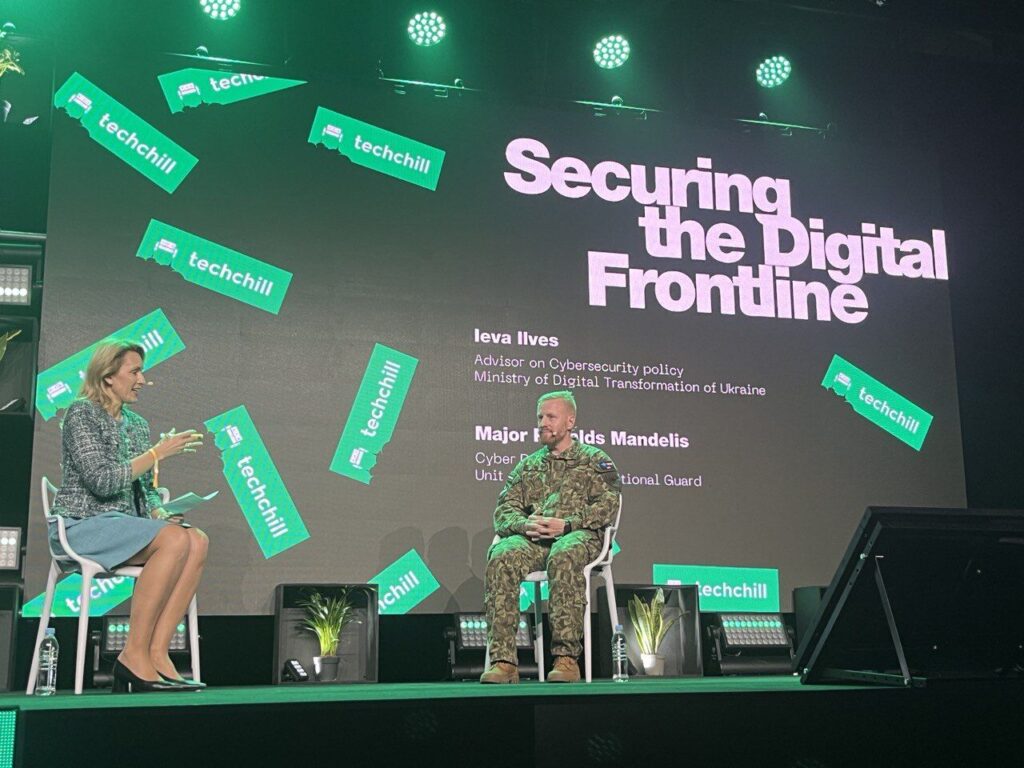Before Russia launched its full-scale invasion of Ukraine in February 2022, the idea of a senior military official—in full uniform—taking the stage at a tech event (where even a suit and tie usually make their wearer look awfully out of place amidst the casually-dressed tech community) would have been viewed as nonsense.
These days, tech is very much defence, and defence is tech. At TechChill in Riga last month, Major Ronalds Mandelis, commander of Latvia’s National Guard Cyber Defence Unit, spoke with Ieva Ilves, who advises Ukraine’s Ministry of Digital Transformation on cybersecurity, explaining that his unit is made up primarily of tech experts who give their time on a volunteer basis, aware that defence of Latvia’s cyberspace is not just about national defence—but defence of their companies.
In March, Latvia’s government approved a new draft cybersecurity law that aims to further strengthen cybersecurity in Latvia, as well as to introduce the revised requirements of the European Union Network and Information Systems Security Directive (NIS2) to achieve a uniformly high level of cyber security throughout the European Union.
“Latvia has so far demonstrated strong cyber resilience. But given our strong stance against Russian aggression in Ukraine, we must be prepared to continue to be the target of Russian cyber-attacks. That is why we are proactively strengthening our cyber capability and cyber security management,” says Defence Minister Andris Sprūds.
Also in March, NATO’s Defence Innovation Accelerator for the North Atlantic (DIANA) programme announced a major expansion of its network of accelerator sites, which will in future include one in Latvia for the first time.
DIANA’s network will now comprise 23 accelerator sites (up from 11) and among the newcomers is UniLab Defence – a Riga based DIANA programme expected to start operations in 2025.
The accelerator site will be set up by UniLab, a Latvian university business incubator that unites all four Latvian science universities – Riga Technical University, the University of Latvia, Riga Stradiņš University and the Latvia University of Life Sciences and Technologies. It will focus on supporting start-ups developing dual-use technologies and will provide training, funding and commercial advice.
“Setting up an accelerator in Latvia will help develop the local ecosystem through attraction of founders to [defence tech] sector and support of companies already developing dual use and defence technologies,” says Andris Baumanis, CEO of UniLab.
Technologies developed through DIANA can also receive funding from the NATO Innovation Fund, one billion euros venture capital fund established by a group of NATO Allies at the 2022 Madrid Summit. The world’s first multi-sovereign venture capital fund, it will invest its funding over a 15-year period in start-ups developing or adapting technologies for defence and security.
Estonia
In neighbouring Estonia, which has been a pioneer in defence tech ever since Russia-based attackers launched a series of denial of service attacks against public and private sector organisations in 2007, the government this month announced the creation of a fund worth 50 million euros to invest in companies developing defence technologies or dual-use technologies through direct equity investments.
The fund will primarily invest in Estonian companies to reduce risks and make them more appealing to private investors.
“Estonia has a very highly developed technology sector, but there is a market failure in the use of this capacity to increase our national security. The state can help with seed funding here,” said Estonia’s prime minister, Kaja Kallas, announcing the fund.
Minister of Economic Affairs and Information Technology Tiit Riisalo meanwhile said that the fund would help double the volume of the Estonian economy by 2035.
“New investments are important for the development of the defence industry, as they support the companies of the field in developing innovative technologies and marketing new solutions.
“In order to launch the funding operationally, we created the SmartCap national investment fund creating a new defence industry fund in addition to the already functioning Risk Capital Fund and Green Fund to manage investments. Those funds allow to involve private capital in the development of defence industry start-ups and deep-tech,” said Riisalo.
Like Latvia, Estonia will also benefit from hosting one of the new NATO DIANA incubators, managed by the Tehnopol Startup Incubator in collaboration with the Sparkup Tartu Science Park and Startup Wise Guys business accelerator.
Lithuania
The third Baltic state, Lithuania, will also host a DIANA incubator, run by Vilnius University and acting as a technology testing, assessment, verification and validation centre.
One of the promising Lithuanian start-ups taking part is Astrolight, which specialises in free space optical communication, a secure and high-bandwidth communications technology that enables two distant objects to communicate using laser beams.
As part of the partnership with DIANA, Astrolight will collaborate with NATO and other defence stakeholders to adapt its laser communication terminals for terrestrial applications. This collaboration will enable Astrolight to utilise its dual-use technology further, expand its product portfolio, and tap into new markets within the defence industry.
“As a commercial company specialising in the development of dual-use telecommunications technology, our partnership with NATO DIANA is pivotal in transitioning our expertise into the defence sector,” says Astrolight’s CEO Laurynas Mačiulis.
“Participation in DIANA’s programme involves guiding us through defence-specific requirements and facilitating our understanding of the nuances associated with this market.”
Over to EU
What remains to be seen now is how much interest the European Union will take in boosting both the Baltic—and wider European—defence tech sector. Current European Commission President Ursula von der Leyen has made defence—and defence investment—a key part of her campaign to stay in the job after June’s European parliament elections.
In February, she called for, “a new European defence mindset from institutions to industries to investors” in a speech to MEPs. Von der Leyen is also keen on the next commission including a specific defence commissioner.
Last week, the European Investment Bank (EIB), the EU’s lending arm, approved an updated definition of dual-use goods and infrastructure eligible for EIB Group financing and agreed to facilitate financing for small and medium-sized enterprises (SMEs) in the security and defence industry, by opening up dedicated intermediated financing.
Going forward, the EIB will waive a previous requirement that dual-use projects eligible for financing in the area of security and defence derive more than 50 per cent of their expected revenues from civilian use.
Projects and infrastructure used by the military or police that also serve civilian needs will now be eligible for EIB Group financing. There will no longer be a minimum threshold for expected revenues from civilian applications or share of civilian users.







